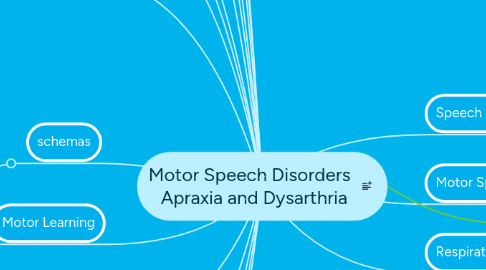Motor Speech Disorders Apraxia and Dysarthria
by Nawal Javaid


1. Phonatory System
1.1. Regulates the production of voice and the prosodic, or intonational, aspects of speech
2. Resonatory system
2.1. Regulates the resonation or vibration of the airflow as it moves from the pharynxx into the oral or nasal cavities.
3. Velopharyngeal port
3.1. the opening between the velum (soft palate) and the back of the pharynx wall
4. Articulatory sytem
4.1. Regulates the control of the articulators within the oral cavity to manipulate the outgoing airflow in different ways, usually at very high speeds.
5. Motor Program
5.1. muscle synergy, an abstract representation of a relatively invariant movement pattern that can be scaled in size and time to meet the demands of the particular situation.
6. Motor Learning
6.1. the way in which practice or experience leads to "relatively" permanent changes in the capability for movement.
7. schemas
7.1. Memory representations of relationships between various sources of information
8. Motor planning and programming disorders
8.1. caused by an inability to group and sequence the relevant muscles in order to plan or program a movement
9. Motor execution disorders
9.1. Caused by deficits or inefficiencies in basic physiological or movement characteristics of the musculature, such as muscle tone, movement speed, and movement range.
10. Dysarthria
10.1. A group of speech disorders caused by disturbances of neuromuscular control of the speech production systems
11. Muscle tone
11.1. The resistance to passive movement and reflects sustained muscle activity that provides postural support for active movements.
12. Muscle strength
12.1. The ability of the muscle to contract to a desired level and may be reduced, as in flaccid dysarthria.
13. Movement steadiness
13.1. The ability of the muscles to generate steady movements and may be disrupted by involuntary movements.
14. Generalization
14.1. Application or transfer of a skill to related but untrained movement patterns.
15. Conditions of Practice
15.1. 1.
15.1.1. Practice variability
15.1.1.1. Conditions of practice refer to factors such as the number of different targets practicied
15.2. 2.
15.2.1. Practice schedule
15.2.1.1. The order in which different targs are practiced
15.3. 3.
15.3.1. Practice Amount
15.3.1.1. Number of practice trials
15.4. 4.
15.4.1. Practice Distrubution
15.4.1.1. How close in time the practice sessions are spaced
